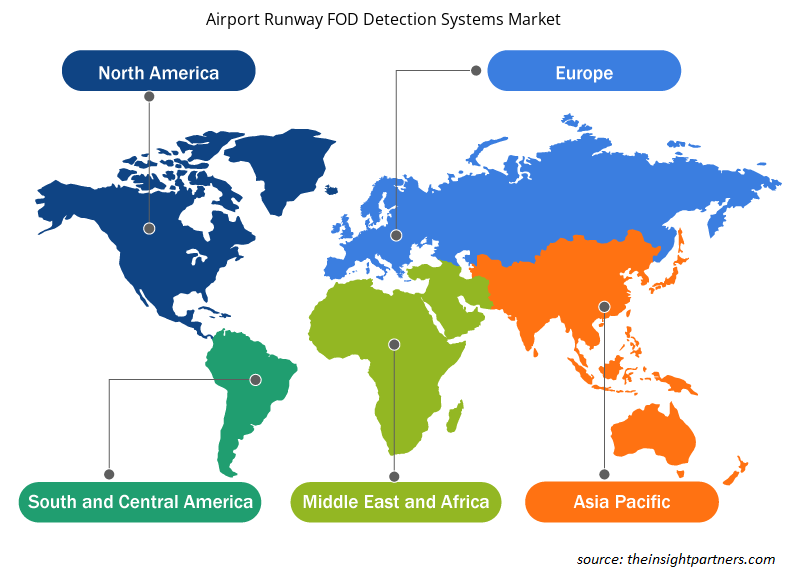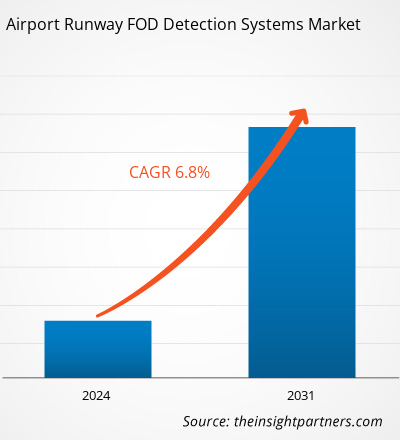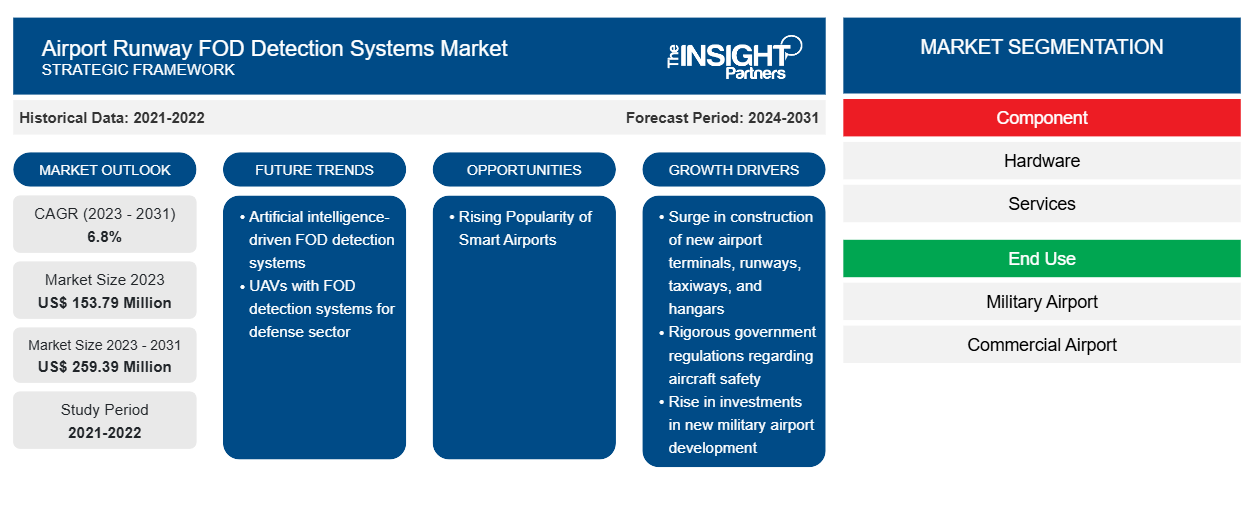Si prevede che il mercato dei sistemi di rilevamento FOD sulle piste aeroportuali raggiungerà i 259,39 milioni di dollari entro il 2031, rispetto ai 153,79 milioni di dollari del 2023. Si prevede che il mercato registrerà un CAGR del 6,8% nel periodo 2023-2031. L'emergere di UAV innovativi con sistemi di rilevamento FOD per il settore della difesa porterà probabilmente nuove tendenze nel mercato.
Analisi di mercato dei sistemi di rilevamento FOD sulle piste aeroportuali
I governi dei paesi sviluppati come Stati Uniti, Regno Unito e Cina stanno capitalizzando sulle tecnologie aeroportuali intelligenti, tra cui sensori intelligenti, telecamere, sistemi di comunicazione e di rete, tag RFID e dispositivi indossabili. Ciò è dovuto ai crescenti requisiti di informazioni in tempo reale e alla crescente domanda di tecnologie di connettività all'avanguardia nelle operazioni aeroportuali. Analogamente, la crescente preferenza dei consumatori per i viaggi aerei e il crescente volume di traffico aereo in tutto il mondo stanno incrementando l'applicazione di sistemi di rilevamento FOD sulle piste aeroportuali in vari aeroporti civili. Inoltre, la crescente spesa per la difesa nei paesi sviluppati ha portato a un aumento dell'adozione di sistemi di rilevamento FOD nel settore militare. Inoltre, si prevede che la crescente implementazione di tecnologie avanzate come cloud, Internet of Things (IoT), blockchain e intelligenza artificiale (AI) da parte dell'industria aerospaziale e della difesa spingerà la crescita del mercato dei sistemi di rilevamento FOD sulle piste aeroportuali nei prossimi anni.
Inoltre, il FOD rappresenta una grande minaccia per la sicurezza e minacce finanziarie per il settore dell'aviazione in tutto il mondo. Secondo la Federal Aviation Administration, ogni anno si verificano perdite per oltre 22,7 miliardi di dollari USA sostenute dalle compagnie aeree e dagli aeroporti in tutto il mondo a causa del FOD. Tali costi rappresentano anche grandi minacce finanziarie per diverse compagnie aeree e aeroporti. Inoltre, tali preoccupazioni stanno spingendo l'adozione di sistemi di rilevamento del FOD in diversi aeroporti in tutto il mondo.
Panoramica del mercato dei sistemi di rilevamento FOD sulle piste aeroportuali
I sistemi di rilevamento FOD (detriti di oggetti estranei) delle piste aeroportuali facilitano principalmente la scansione automatizzata delle superfici aeroportuali, delle vie di rullaggio e delle piste; conferiscono un'elevata capacità di rilevamento e risoluzione; e forniscono una maggiore consapevolezza della situazione, confermando così una maggiore sicurezza per gli utenti. La crescente attenzione delle autorità governative alla costruzione di aeroporti intelligenti aumenta la domanda di integrazione di tecnologie e sistemi intelligenti nei locali aeroportuali per un funzionamento e una gestione efficienti.
Personalizza questo report in base alle tue esigenze
Riceverai la personalizzazione gratuita di qualsiasi report, comprese parti di questo report, o analisi a livello nazionale, pacchetto dati Excel, oltre a usufruire di grandi offerte e sconti per start-up e università
-
Scopri le principali tendenze di mercato in questo rapporto.Questo campione GRATUITO includerà analisi di dati che spaziano dalle tendenze di mercato alle stime e alle previsioni.
Driver di mercato e opportunità per i sistemi di rilevamento FOD sulle piste aeroportuali
Aumento della costruzione di nuovi terminal aeroportuali, piste, vie di rullaggio e hangar
Il crescente numero di flotte di aeromobili commerciali globali è uno dei principali fattori che generano la domanda di nuovi voli, terminal, piste e hangar in diversi aeroporti per soddisfare il crescente traffico passeggeri in tutto il mondo. Ciò alimenta gli investimenti delle autorità aeroportuali per aggiornare i rispettivi locali aeroportuali per soddisfare un'enorme flotta di aeromobili, il che migliora anche l'efficienza operativa complessiva dell'aeroporto. L'efficienza migliorata è anche attribuita all'introduzione di compagnie aeree low-cost che hanno supportato il traffico passeggeri aereo in tutto il mondo. A marzo 2023, il consiglio comunale canadese di Kelowna ha annunciato l'approvazione per un finanziamento di 90 milioni di dollari USA per il progetto di ampliamento del terminal dell'aeroporto di Kelowna. Anche diverse autorità governative di diversi paesi hanno pianificato di costruire nuovi aeroporti nei rispettivi paesi per migliorare il flusso del commercio internazionale di merci e lo sviluppo del settore dei viaggi aerei. Ad esempio, negli Stati Uniti, sei nuovi aeroporti sono attualmente in costruzione. Inoltre, nel 2022, il governo indiano ha annunciato i suoi piani per costruire circa 220 aeroporti entro la fine del 2025. Numerosi progetti sono in corso in tutto il paese; ad esempio, il progetto di ampliamento dell'aeroporto internazionale Sardar Vallabhbhai Patel, il nuovo aeroporto internazionale di Navi Mumbai, l'aeroporto internazionale di Noida, il progetto di ampliamento dell'aeroporto internazionale di Kempegowda e il progetto di ampliamento dell'aeroporto internazionale Indira Gandhi.
Nel 2018, la Civil Aviation Administration of China (CAAC) ha annunciato i suoi piani per costruire ~216 nuovi aeroporti entro la fine del 2035. Questo piano probabilmente aumenterà il numero totale di aeroporti a ~450 aeroporti entro il 2035 (attualmente 234 aeroporti nel 2023). Nel 2023, l'aeroporto internazionale di Yangzhou Taizhou (YTY) ha avviato il suo progetto di espansione per raggiungere e gestire 10 milioni di passeggeri; 88.670 movimenti di aeromobili; e 50.000 tonnellate di merci all'anno. Inoltre, a maggio 2021, l'aeroporto internazionale di Kansai (KIX) ha avviato un progetto di espansione incentrato sulla gestione di ~40 milioni di passeggeri internazionali all'anno. Si prevede che il progetto sarà completato entro il 2025 per l'Expo 2025 di Osaka nel Kansai. Pertanto, la costruzione di nuovi terminal aeroportuali, piste, vie di rullaggio e hangar contribuisce alla crescita del mercato dei sistemi di rilevamento FOD delle piste aeroportuali.
Crescente popolarità degli aeroporti intelligenti
La crescente inclinazione delle autorità governative verso gli aeroporti intelligenti aumenta la domanda di implementazione di sistemi intelligenti nei locali aeroportuali. I governi di paesi sviluppati come Stati Uniti, Regno Unito e Cina stanno capitalizzando sulle tecnologie aeroportuali intelligenti, tra cui sistemi di comunicazione e di rete, sensori intelligenti, telecamere, tag RFID e dispositivi indossabili, a causa della crescente preferenza per le informazioni in tempo reale e della crescente domanda di tecnologie di connettività avanzate nelle operazioni aeroportuali. Ad esempio, nel 2017, la Civil Aviation Authority of Singapore (CAAS) e NATS Limited hanno implementato la torre digitale intelligente nell'aeroporto di Changi, che continua a migliorare le capacità di sorveglianza e comunicazione. Inoltre, il governo del Canada ha fornito finanziamenti per circa 16 milioni di dollari USA nel periodo 2021-2022 all'aeroporto internazionale di Ottawa per il ripristino della pavimentazione sulle vie di rullaggio A, M, AA, BB e CC, nonché per la costruzione di una stazione di transito della metropolitana leggera presso l'aeroporto.
Analisi della segmentazione del rapporto di mercato dei sistemi di rilevamento FOD delle piste aeroportuali
I segmenti chiave che hanno contribuito alla derivazione dell'analisi di mercato dei sistemi di rilevamento FOD sulle piste aeroportuali sono i componenti e l'utilizzo finale.
- In base al componente, il mercato globale dei sistemi di rilevamento FOD delle piste aeroportuali è segmentato in hardware e servizi. Il segmento hardware ha detenuto la quota di mercato maggiore nel 2023.
- In base all'uso finale, il mercato è diviso in aeroporti militari e aeroporti commerciali. Il segmento degli aeroporti commerciali ha detenuto la quota maggiore del mercato nel 2023.
Analisi della quota di mercato dei sistemi di rilevamento FOD delle piste aeroportuali per area geografica
L'ambito geografico del rapporto di mercato sui sistemi di rilevamento FOD sulle piste aeroportuali è suddiviso principalmente in cinque regioni: Nord America, Asia Pacifico, Europa, Medio Oriente e Africa, e Sud e Centro America.
Il settore dell'aviazione in Nord America sta assistendo a una significativa espansione e sviluppo, rispondendo alle crescenti richieste di viaggi aerei e alla vitalità economica della regione. Gli aeroporti principali, tra cui l'aeroporto internazionale di Atlanta Hartsfield-Jackson, l'aeroporto internazionale di Los Angeles e l'aeroporto internazionale di Dallas/Fort Worth, stanno subendo progetti di modernizzazione per accogliere un traffico passeggeri in crescita. Gli Stati Uniti hanno il numero più alto di aeroporti al mondo, nonché un numero significativo di sviluppatori di tecnologie aeroportuali. Ciò rende più facile per le autorità aeroportuali acquistare grandi quantità di tecnologie o sistemi aeroportuali, tra cui sistemi di rilevamento FOD, guidando così il mercato dei sistemi di rilevamento FOD delle piste aeroportuali. Il rapporto di Airport Council International (ACI-NA) ha evidenziato che l'infrastruttura aeroportuale del Nord America richiede 151,1 miliardi di dollari per la manutenzione o l'espansione dal 2023 al 2027.
Gli sforzi in corso della Federal Aviation Administration (FAA) per sviluppare infrastrutture aeroportuali e di pista solide e sicure stanno incoraggiando le autorità aeroportuali a investire in tecnologie avanzate come i sistemi di rilevamento FOD. Pertanto, la significativa necessità di modernizzazione delle tecnologie aeroportuali e di pista da parte della FAA è un altro fattore chiave che guida il mercato dei sistemi di rilevamento FOD delle piste aeroportuali in Nord America. Inoltre, la Canadian Airports Authority e la successiva gestione aeroportuale sottolineano sempre la manutenzione delle piste per prevenire i tempi di fermo pista dovuti a incidenti in pista. Per garantire il movimento costante delle flotte di aeromobili da e per l'aeroporto, le amministrazioni aeroportuali stanno installando sistemi di rilevamento FOD sulle piste, il che sta incrementando il mercato dei sistemi di rilevamento FOD delle piste nella regione. Alcuni dei principali attori che operano nel mercato dei sistemi di rilevamento FOD delle piste aeroportuali in Nord America includono Pavemetrics Systems; QinetiQ; Thales Group; Varec, Inc.; e XSight Systems Ltd.; tra gli altri.
Approfondimenti regionali sul mercato dei sistemi di rilevamento FOD sulle piste aeroportuali
Le tendenze regionali e i fattori che influenzano il mercato dei sistemi di rilevamento FOD delle piste aeroportuali durante il periodo di previsione sono stati ampiamente spiegati dagli analisti di Insight Partners. Questa sezione discute anche i segmenti di mercato dei sistemi di rilevamento FOD delle piste aeroportuali e la geografia in Nord America, Europa, Asia Pacifico, Medio Oriente e Africa e America meridionale e centrale.

- Ottieni i dati specifici regionali per il mercato dei sistemi di rilevamento FOD delle piste aeroportuali
Ambito del rapporto di mercato sui sistemi di rilevamento FOD delle piste aeroportuali
| Attributo del report | Dettagli |
|---|---|
| Dimensioni del mercato nel 2023 | 153,79 milioni di dollari USA |
| Dimensioni del mercato entro il 2031 | 259,39 milioni di dollari USA |
| CAGR globale (2023-2031) | 6,8% |
| Dati storici | 2021-2022 |
| Periodo di previsione | 2024-2031 |
| Segmenti coperti |
Per componente
|
| Regioni e Paesi coperti |
America del Nord
|
| Leader di mercato e profili aziendali chiave |
|
Sistemi di rilevamento FOD delle piste aeroportuali Densità degli attori del mercato: comprendere il suo impatto sulle dinamiche aziendali
Il mercato dei sistemi di rilevamento FOD sulle piste degli aeroporti sta crescendo rapidamente, spinto dalla crescente domanda degli utenti finali dovuta a fattori quali l'evoluzione delle preferenze dei consumatori, i progressi tecnologici e una maggiore consapevolezza dei vantaggi del prodotto. Con l'aumento della domanda, le aziende stanno ampliando le loro offerte, innovando per soddisfare le esigenze dei consumatori e capitalizzando sulle tendenze emergenti, il che alimenta ulteriormente la crescita del mercato.
La densità degli operatori di mercato si riferisce alla distribuzione di aziende o società che operano in un particolare mercato o settore. Indica quanti concorrenti (operatori di mercato) sono presenti in un dato spazio di mercato in relazione alle sue dimensioni o al valore di mercato totale.
Le principali aziende che operano nel mercato dei sistemi di rilevamento FOD sulle piste aeroportuali sono:
- ArgosAI Teknoloji A.?.
- Azienda
- Radar di Navtech
- Pavemetria
- Servizi Plextek limitati
- Rheinmetall AG
Disclaimer : le aziende elencate sopra non sono classificate secondo un ordine particolare.

- Ottieni una panoramica dei principali attori del mercato dei sistemi di rilevamento FOD sulle piste degli aeroporti
Notizie di mercato e sviluppi recenti sui sistemi di rilevamento FOD delle piste aeroportuali
Il mercato dei sistemi di rilevamento FOD delle piste aeroportuali viene valutato raccogliendo dati qualitativi e quantitativi dopo la ricerca primaria e secondaria, che include importanti pubblicazioni aziendali, dati associativi e database. Di seguito sono elencati alcuni degli sviluppi nel mercato dei sistemi di rilevamento FOD delle piste aeroportuali:
Smiths Detection ha accelerato la partnership con SeeTrue. Smiths Detection ha integrato e testato con successo la tecnologia SeeTrue nei nostri sistemi di checkpoint di sicurezza CT. Smiths Detection, leader mondiale nel rilevamento delle minacce e nello screening di sicurezza, e un'azienda di Smiths Group, ha annunciato un importante passo avanti nella tecnologia di sicurezza dell'aviazione. Lavorando in partnership con SeeTrue, un fornitore di software di rilevamento delle minacce basato sull'intelligenza artificiale, Smiths Detection ha integrato e testato con successo la tecnologia SeeTrue nei suoi sistemi avanzati di checkpoint di sicurezza CT con la soluzione combinata ora pronta per l'implementazione immediata in attesa di certificazione. (Fonte: Smiths Detection, comunicato stampa, ottobre 2023)
Copertura e risultati del rapporto di mercato sui sistemi di rilevamento FOD sulle piste aeroportuali
Il rapporto "Dimensioni e previsioni del mercato dei sistemi di rilevamento FOD sulle piste degli aeroporti (2021-2031)" fornisce un'analisi dettagliata del mercato che copre le seguenti aree:
- Dimensioni e previsioni del mercato dei sistemi di rilevamento FOD delle piste aeroportuali a livello globale, regionale e nazionale per tutti i principali segmenti di mercato coperti dall'ambito
- Tendenze del mercato dei sistemi di rilevamento FOD sulle piste aeroportuali, nonché dinamiche di mercato quali conducenti, sistemi di ritenuta e opportunità chiave
- Analisi PEST e SWOT dettagliate
- Analisi di mercato dei sistemi di rilevamento FOD sulle piste aeroportuali che copre le principali tendenze del mercato, il quadro globale e regionale, i principali attori, le normative e i recenti sviluppi del mercato
- Analisi del panorama industriale e della concorrenza che copre la concentrazione del mercato, l'analisi della mappa di calore, i principali attori e gli sviluppi recenti per il mercato dei sistemi di rilevamento FOD delle piste aeroportuali
- Profili aziendali dettagliati
- Analisi storica (2 anni), anno base, previsione (7 anni) con CAGR
- Analisi PEST e SWOT
- Valore/volume delle dimensioni del mercato - Globale, Regionale, Nazionale
- Industria e panorama competitivo
- Set di dati Excel
Report recenti
Testimonianze
Motivo dell'acquisto
- Processo decisionale informato
- Comprensione delle dinamiche di mercato
- Analisi competitiva
- Analisi dei clienti
- Previsioni di mercato
- Mitigazione del rischio
- Pianificazione strategica
- Giustificazione degli investimenti
- Identificazione dei mercati emergenti
- Miglioramento delle strategie di marketing
- Aumento dell'efficienza operativa
- Allineamento alle tendenze normative























 Ottieni un campione gratuito per - Mercato dei sistemi di rilevamento FOD sulle piste aeroportuali
Ottieni un campione gratuito per - Mercato dei sistemi di rilevamento FOD sulle piste aeroportuali